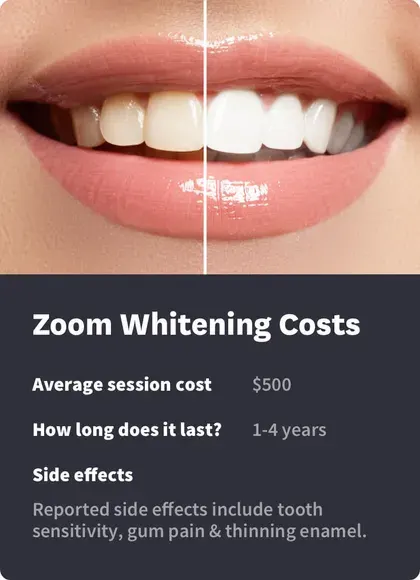Zoom Whitening - Is It Worth the Cost?

Table of Contents
- What is Zoom Teeth Whitening?
- How Does It Work?
- Cost & Effectiveness
- The Procedure
- Side Effects
- Frequently Asked Questions
- References
When you have yellow or gray teeth or any other kind of tooth stain, it can be a source of discomfort and worry, affecting your confidence in public, your smile and can even cause lost job opportunities or clients.
Tooth discoloration has several causes, but drinks and foods are the most common. For example, caffeine, soft drinks and red wine, along with fruits like apples, more easily stain your teeth. And habits like smoking tobacco, along with poor dental hygiene, old age and certain medications and medical conditions also can have a strong staining effect on your teeth.
Thankfully, stains don’t have to be a permanent feature of your facial appearance since you can use teeth whitening techniques, like Zoom Whitening, an increasingly popular and effective method.
If you are considering using Zoom whitening as a cleansing option, here is what you need to know.
What is Zoom Teeth Whitening?
Zoom teeth whitening is a cosmetic dental procedure that uses a bleaching system to lighten discolored dentin and enamel. Zoom is usually performed as an in-office procedure, using a hydrogen peroxide gel and the Zoom advanced power chair-side lamp, an ultraviolet (UV) device that speeds up peroxide’s bleaching action.
How Does Zoom Whitening Work?
The gel that covers your teeth contains a high concentration of hydrogen peroxide. Light from the UV lamp breaks it down, and a thin layer dissolves on the enamel, releasing oxygen into the teeth. Oxygen then bleaches and flushes out teeth stains, leaving teeth clear and with the structure intact.
Zoom Whitening Cost and Effectiveness

A Zoom whitening session averages around $500, which includes an aftercare package your dental professional will give you for home use. The investment is well worth it: the results are immediate and will last from one to four years.
The procedure also has several other benefits: it takes less than an hour and any side effects typically last only a few days.
The Zoom Whitening Procedure
The Zoom procedure starts with your dental professional applying a protective material onto your lips and gums to protect them against the whitening gel. Next, with only your teeth exposed, the professional then applies the gel and uses the Zoom UV light to activate the hydrogen peroxide so that it can penetrate your teeth and remove stains and discoloration.
Gel activation and stain-removing action takes about 15 minutes. During this time, you can sit and relax with your phone, tablet or in front of the TV. However, if you have a strong gag reflex, you may find the process uncomfortable.
When the first 15 minutes is over, the professional will repeat the process two more times. The entire procedure takes a about an hour (three 15-minute sessions, plus application time). Once the sessions are complete, the dentist applies a sensitivity-reducing paste.
During the procedure, you may have brief pain flashes as your teeth’s nerves interact with the gel. Tell your dentist or dental assistants about any pain you are experience. They will stop the procedure if your pain is severe.
Any pain could continue beyond the procedure, which is why several dentists will give you pain relievers to use until the pain recedes. Pain tolerance varies among people, but the Zoom whitening procedure is not recommended for people with sensitivity issues.
After the procedure, your teeth will have an almost unnatural white color, but they will regain their natural hue in a few days.
Does Zoom Whitening Have Side Effects?
Dental experts regard Zoom whitening as one of the safest whitening procedures. If you use qualified personnel, you will have zero to minimal side effects. Whatever side effects that you do experience, can last from a few hours to a day or two.
Common side effects include:
Sensitivity: This is the most common side effect, which happens because the dentin layer below the enamel triggers a chemical reaction when it comes in contact with the whitening gel. The sensitivity lasts several hours to a day although longer in some cases. Your dental professional will advise you on aftercare tips to manage teeth sensitivity.
Tooth or gum pain: The chemical in the gel may reach the tooth pulp triggering discomfort, ranging from dull aches to random sharp pain, lasting for a day or two. You can manage this pain with OTC pain relievers.
Irritated gums and soft tissue: Sometimes the gel may irritate your teeth or the soft tissues in your mouth, resulting in soreness, irritation, blistering or white spots. The best solution is prevention. Only let an experienced professional provide the best protective cover and accurately apply the gel.
Thinning enamel: Frequent whitening procedures can cause thinner enamel. Fortunately, Zoom Whitening results last longer, reducing the need for frequent sessions.
Frequently Asked Questions
When performed correctly, Zoom is a safe procedure that whitens your teeth without damaging them. Zoom procedures last for longer and keep your teeth whiter and healthier. The larger concern about Zoom is its reliance on radiation and the precautions that radiation requires. This makes is necessary for a dental professional perform the Zoom.
Zoom whitening and bleaching are not the same. Teeth-whitening is the physical process of removing stains. Bleaching often requires chemical use to penetrate top levels of the dentine and enamel.
There are numerous factors that affect the pricing of Zoom whitening, but the average cost of the procedure is $500.
